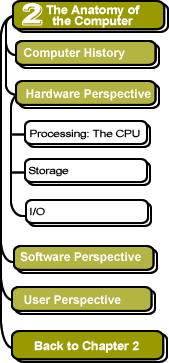

|

Storage
The second main subsystem of a computer system is storage.
There are two kinds of storage:
- Primary storage—also known as "memory," or "RAM"
- Secondary storage, which is "permanent" storage, such as a disk or a tape.
Primary Storage: Memory
While the CPU does all of the processing for the rest of the
computer system, it doesn't hang on to any of the results it produces.
(The CPU only has a small amount of storage, called registers,
that it uses as a scratchpad.)
Thus, a computer's memory system is necessary to provide a large-capacity location for the CPU to store and retrieve linformation. It can be thought of as the CPU's workspace. Just as having a good workspace allows you to shuffle papers and books, write things down, look things up, stack related information, so the CPU, too, needs adequate room to work.
Any software instructions for the CPU must be loaded into primary memory first. Thus, in order to run Microsoft Word, the lengthy list of binary instructions that make up Microsoft Word must first be loaded into the computer's memory. Then the CPU can begin executing these intructions one at a time. If your computer doesn't have enough memory to load all of the software from the disk into memory, then the CPU will have to do a kind of a "juggling act," swapping software pieces between (fast) main memory and the (slow) disk. This really slows down your computer!
On the other hand, when your computer system has plenty of memory, then your CPU has more than enough room to operate. So before you get rid of that "old" computer that you think is "slow," try putting extra memory (RAM) in it first. This upgrade is usually very affordable (often less than $50), and the difference can be very surprising: a slower CPU with plenty of memory will outperform a faster CPU that has insufficient memory! Memory chips come packaged on a little module called either a SIMM or a DIMM that literally snaps in to the main board (motherboard) inside your computer. (You can almost certainly find a friend who can put this extra memory in for you if you aren't comfortable doing so.)
What Exactly Are Memory Chips?
Memory (RAM) chips have some similarities to CPU chips: both are made from silicon wafers and are packed densely with transistors (little electronic on/off switches). However, as we've learned, in a CPU chip all of the transistors are wired so that they will flip appropriately in response to a given input, setting off a chain reaction of flipping switches that eventually ends with the last line of switches, which represents the output result.
In contrast, the transistors that make up the storage area on a memory chip are all set to the zero (off) position until the CPU sends electrical signals to memory that flips some of the switches to the one (on) position, thereby storing a binary number in memory. However, whenever the computer is turned off, all of the electronic switches (transistors) in the memory chip flip back to their zero position. Thus, all of the changes made by the CPU are lost.
For this reason, memory (RAM) is said to be volatile, because it only retains its contents as long as it is supplied with electricity. If you type a term paper and don't save it to permanent storage (e.g., a disk), then it will be lost: what is displayed on the screen is merely a depiction of what is stored in primary memory.
On the other hand, if some conflicts have emerged between the many programs loaded into your computer's memory, and your software begins to behave abnormally, simply turning off the computer will solve the problem, because it completely clears out the memory and gives the software a chance to reload properly.
![]()
![]()
These pages were written by Steven H. VanderLeest and Jeffrey Nyhoff and edited by Nancy Zylstra
©2005 Calvin University (formerly Calvin College), All Rights Reserved
If you encounter technical errors, contact computing@calvin.edu.